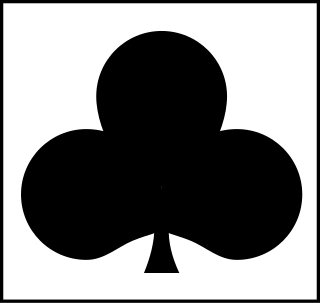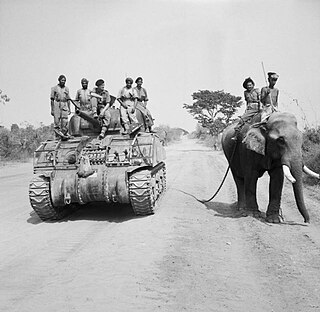Related Research Articles

The King's African Rifles (KAR) was a British Colonial Auxiliary Forces regiment raised from Britain's East African colonies in 1902. It primarily carried out internal security duties within these colonies along with military service elsewhere during the world wars and other conflicts, such as the Malayan Emergency and the Mau Mau uprising. The regiment's enlisted soldiers were drawn from the native Africans, while most officers were seconded from the British Army. During the 1960s, as part of the decolonisation of Africa, more African officers were commissioned into the regiment before it was gradually disbanded. KAR battalions would go on to form the core of newly established armed forces throughout East Africa.

The Indian Army during World War II, a British force also referred to as the British Indian Army, began the war, in 1939, numbering just under 200,000 men. By the end of the war, it had become the largest volunteer army in history, rising to over 2.5 million men in August 1945. Serving in divisions of infantry, armour and a fledgling airborne force, they fought on three continents in Africa, Europe and Asia.

The 1st (African) Division was a British Empire colonial unit during the Second World War. The division was formed on 24 July 1940 in East Africa. On 24 November of that year, the division was re-designated as the British Army's 11th (African) Division. The division were composed primarily of West African and East African troops. It was disbanded on 23 November 1941 and its component units reassigned.

The Welch Regiment was an infantry regiment of the line of the British Army in existence from 1881 until 1969. The regiment was created in 1881 under the Childers Reforms by the amalgamation of the 41st (Welch) Regiment of Foot and 69th Regiment of Foot to form the Welsh Regiment, by which it was known until 1920 when it was renamed the Welch Regiment. In 1969 the regiment was amalgamated with the South Wales Borderers to form the Royal Regiment of Wales.
The Ghana Regiment is an infantry regiment that forms the main fighting element of the Ghanaian Army (GA).

The 5th Infantry Division is an infantry division of the Indian Army. It was raised during the second world war and fought in several theatres of war and was nicknamed the "Ball of Fire". It was one of the few Allied divisions to fight against three different armies - the Italian, German and Japanese armies.

The West African Frontier Force (WAFF) was a multi-battalion field force, formed by the British Colonial Office in 1900 to garrison the West African colonies of Nigeria, Gold Coast, Sierra Leone and Gambia. In 1928, it received royal recognition, becoming the Royal West African Frontier Force (RWAFF).

The Nigeria Regiment was a British Colonial Auxiliary Forces unit of the Royal West African Frontier Force was formed by the amalgamation of the Northern Nigeria Regiment and the Southern Nigeria Regiment on 1 January 1914.

The 23rd Infantry Brigade was an infantry brigade of the British Army that saw active service in the First World War, mainly on the Western Front During the Second World War, the brigade saw active service in the Syria-Lebanon Campaign, the Western Desert Campaign, and the Burma Campaign.

The 23rd Armoured Brigade, originally formed as the 23rd Army Tank Brigade, was an armoured brigade of the British Army that saw service during the Second World War. The brigade was a 2nd Line Territorial Army (TA) formation. It was reorganised and renamed the 23rd Armoured Brigade, when it was assigned to the 8th Armoured Division, although it never operated under command of the division.

The 14th Indian Infantry Division was an infantry division of the Indian Army during World War II. It fought in the Arakan Campaign 1942–43, and was subsequently converted into a Training Division, providing drafts of replacements for units of the Fourteenth Army during the Burma Campaign.

The Border Regiment was a line infantry regiment of the British Army, which was formed in 1881 under the Childers Reforms by the amalgamation of the 34th (Cumberland) Regiment of Foot and the 55th (Westmorland) Regiment of Foot.

The 81st Division was formed under British control during the Second World War. It took part in the Burma Campaign.

The 82nd Division was formed under British control during the Second World War. It took part in the later stages of the Burma Campaign and was disbanded in Burma between May and September 1946.
The 254th Indian Tank Brigade was an armoured brigade of the Indian Army during World War II.

The 255th Indian Tank Brigade was an armoured brigade of the Indian Army during World War II. It was part of the Fourteenth Army and saw action in the Burma Campaign. The 255th Tank Brigade's tactical sign was a black bull, with yellow horns and red eyes, on a royal blue triangle. The brigade fought with the 17th Indian Infantry Division in Burma and was involved in the Battle of Meiktila, the Battle of Pokoku and Irrawaddy River operations and during Operation Dracula.
The 2nd Infantry Brigade was a Second World War formation of the British Army. It was formed from battalions of the Royal West African Frontier Force in 1940. In the early part of the war, the Brigade served in the East African campaign before seeing action against the Japanese in Burma in 1944–45.

At the start of 1939, the British Army was, as it traditionally always had been, a small volunteer professional army. At the beginning of the Second World War on 1 September 1939, the British Army was small in comparison with those of its enemies, as it had been at the beginning of the First World War in 1914. It also quickly became evident that the initial structure and manpower of the British Army was woefully unprepared and ill-equipped for a war with multiple enemies on multiple fronts. During the early war years, mainly from 1940 to 1942, the British Army suffered defeat in almost every theatre of war in which it was deployed. But, from late 1942 onwards, starting with the Second Battle of El Alamein, the British Army's fortunes changed and it rarely suffered another defeat. While there are a number of reasons for this shift, not least the entrance of both the Soviet Union and the United States in 1941, as well as the cracking of the Enigma code that same year, an important factor was the stronger British Army. This included better equipment, leadership, training, better military intelligence and mass conscription that allowed the army to expand. During the course of the war, eight men would be promoted to the rank of Field Marshal, the army's highest rank. By the end of the Second World War in September 1945, over 3.5 million men and women had served in the British Army, which had suffered around 720,000 casualties throughout the conflict.

Nigeria participated in World War II as a British colony in September 1939, following the government's acceptance of the United Kingdom's declaration of war on Nazi Germany and entering the war on the side of the Allies. It was a key country in the African theatre, a critical part of the Allied strategy in Africa. In addition to its importance as a staging point in Africa, several Nigerian infantry regiments were raised to serve the British Empire in campaigns in Africa and Asia. 45,000 Nigerian soldiers served in the British Armed Forces in Africa and southeast Asia, and Nigerian regiments formed the majority of the 81st and 82nd West African Divisions of the British Army.
The 22nd Infantry Brigade was a brigade sized formation of the British Army, which was founded on 19 September 1939 at Colito Barracks in Dar es Salaam in British East Africa. The brigade was initially called the 2nd Infantry Brigade, but was redesignated on 18 October 1940 as the 22nd Infantry Brigade. The brigade was composed of units from the King's African Rifles, the Northern Rhodesia Regiment and the Rhodesian African Rifles.
References
- Jackson, Ashley (2006). The British Empire and the Second World War. Continuum International Publishing Group. ISBN 978-1-85285-417-1.
- Mockler, Anthony (2003). Haile Selassie's War. New York: Olive Branch. ISBN 978-1-5665-6473-1.
- Moreman, T. R. (2005). The Jungle, the Japanese and the British Commonwealth Armies at War, 1941–45. Routledge. ISBN 978-0-7146-4970-2.